When it comes to nature’s masters of disguise, few creatures can rival the remarkable camouflage abilities of the Asian vine snake. Also known as the “falling leaf snake,” this slender reptile has evolved one of the most ingenious disguises in the animal kingdom – mimicking a dead leaf drifting from a tree branch. This extraordinary adaptation not only helps it avoid predators but also enables it to ambush unsuspecting prey. In this article, we’ll explore the fascinating world of this serpentine illusionist and discover how its leaf-like appearance has helped it thrive in the forests of Southeast Asia.
The Asian Vine Snake: Nature’s Perfect Impersonator

The snake that mimics a falling leaf is scientifically known as Ahaetulla prasina, commonly called the Asian vine snake or Oriental whip snake. This slender arboreal species belongs to the Colubridae family and is native to the tropical forests of Southeast Asia. With its elongated body that can reach up to 6 feet in length and a weight of just a few ounces, this snake epitomizes the perfect balance between form and function. The most striking feature of this remarkable reptile is its highly specialized body shape and coloration that have evolved specifically to blend in with its leafy forest habitat.
Evolutionary Marvel: The Leaf-Like Appearance
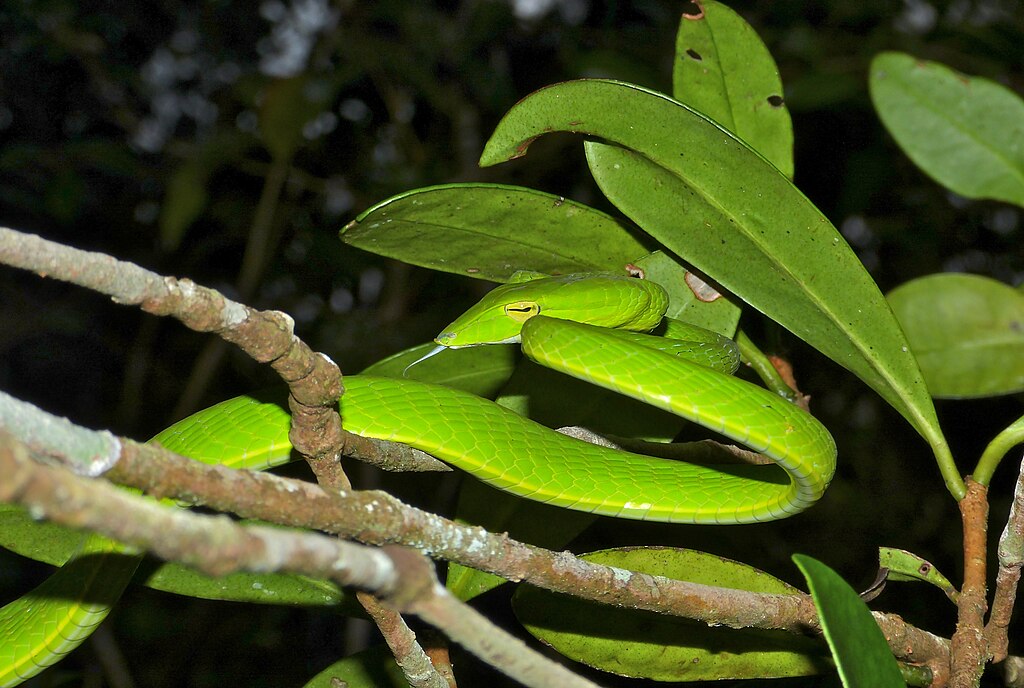
The Asian vine snake’s leaf mimicry is a textbook example of evolutionary adaptation through natural selection. Its body is extremely thin and laterally compressed, creating a leaf-like profile when viewed from the side. The snake’s head is distinctly elongated and pointed, resembling the tip of a leaf, while its body tapers toward the tail, mimicking a leaf’s stem. Most specimens display vibrant green coloration that matches the surrounding foliage, though some individuals may exhibit brown or gray hues that resemble dead or dying leaves. This remarkable resemblance to foliage is further enhanced by irregular patterns and markings along the body that mimic leaf veins and blemishes.
The Falling Leaf Performance: A Behavioral Masterpiece
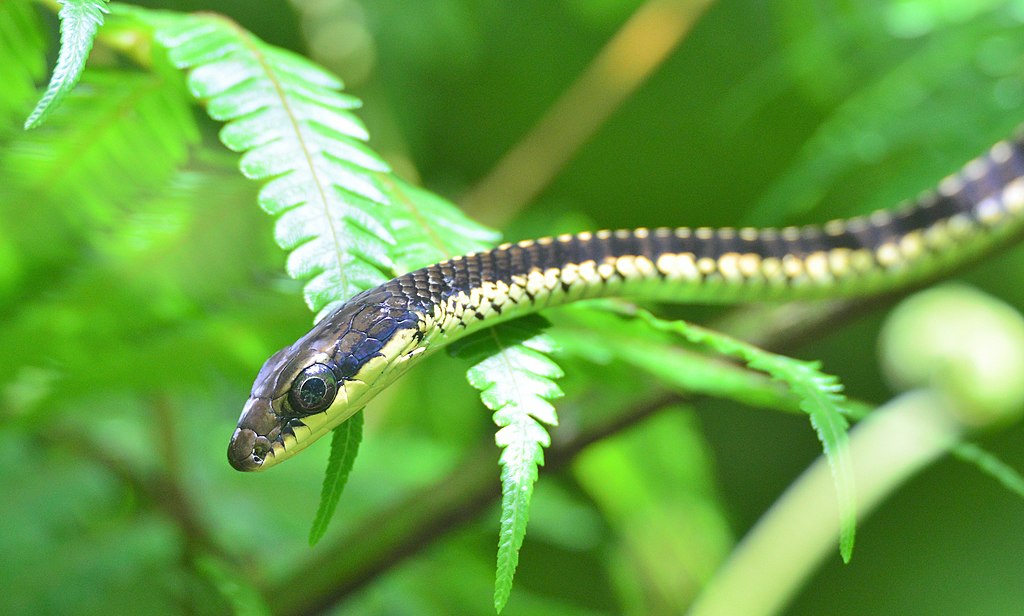
What truly elevates the Asian vine snake’s camouflage beyond mere appearance is its extraordinary behavioral adaptation – the falling leaf performance. When threatened or hunting, the snake will position itself on a branch and allow its body to hang limply, swaying gently in the breeze exactly like a leaf about to fall. This behavior is so convincing that even keen-eyed predators or prey animals dismiss the snake as nothing more than vegetation. The snake can maintain this posture for extended periods, sometimes hours, displaying remarkable patience as it waits for the perfect moment to strike or escape notice. This combination of physical appearance and behavioral mimicry represents one of the most sophisticated camouflage strategies in the animal kingdom.
Facial Features: The Eyes Have It
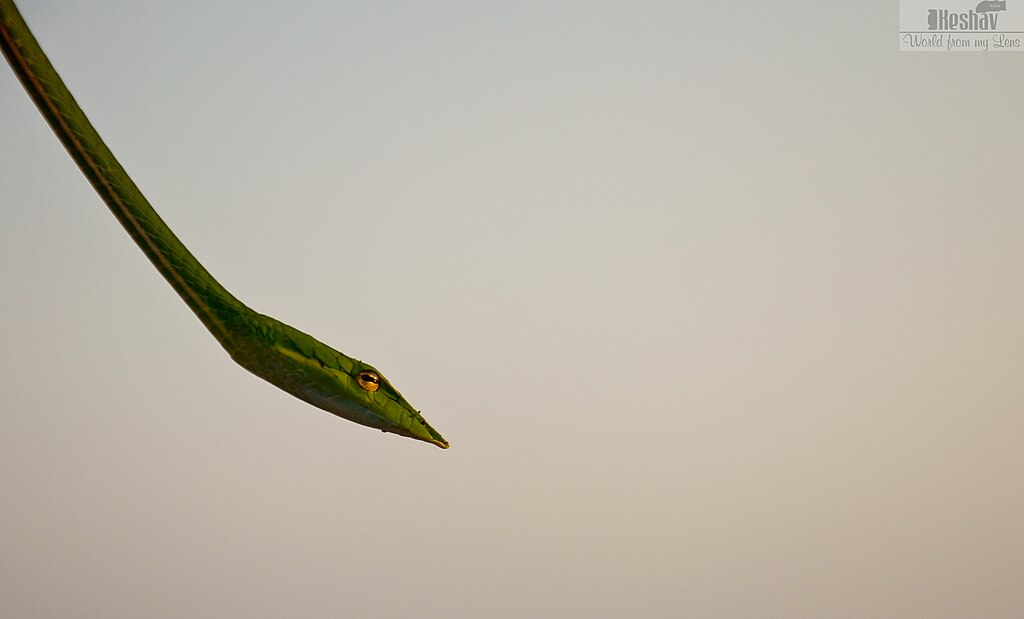
Perhaps the most distinctive feature of the Asian vine snake is its unusual horizontal, keyhole-shaped pupils that provide enhanced panoramic vision – a crucial adaptation for a predator that hunts in three-dimensional forest environments. These unique eyes give the snake excellent depth perception and allow it to accurately judge distances when striking at prey. Surrounding the eyes is often a contrasting stripe that runs from the snout through the eye to the neck, breaking up the outline of the head and further enhancing its camouflage. The snake’s snout is extremely pointed, often with a slightly upturned tip that perfectly mimics the pointed end of certain leaf types found in its habitat.
Hunting Strategy: The Patient Ambush Predator
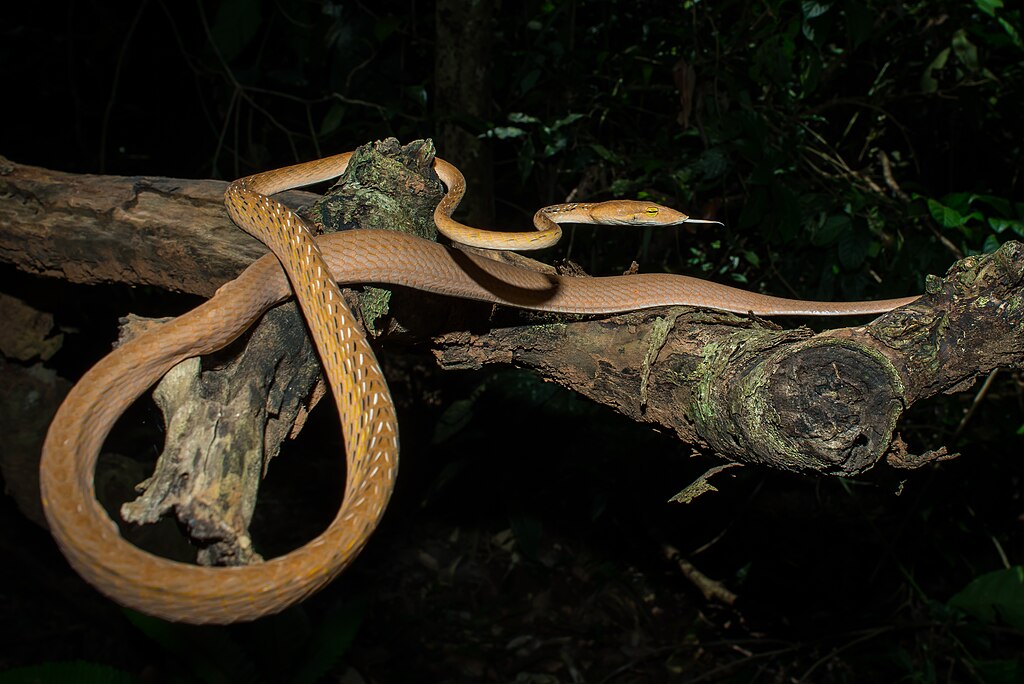
The Asian vine snake’s hunting strategy relies heavily on its remarkable camouflage and patient nature. Unlike many snake species that actively pursue prey, this arboreal hunter is a master of the ambush. It will position itself along branches frequently used by small lizards, frogs, birds, and other small vertebrates, and then remain motionless, often for hours, waiting for an unwary victim to pass within striking distance. When prey approaches, the snake slowly positions its head, calculating distance and trajectory with its specialized vision. The strike itself is lightning-fast and precise, with the snake’s elongated body providing exceptional reach and accuracy. After capturing prey with its small but effective rear fangs, the snake typically consumes its meal while still hanging from a branch.
Venom Profile: Mild But Effective
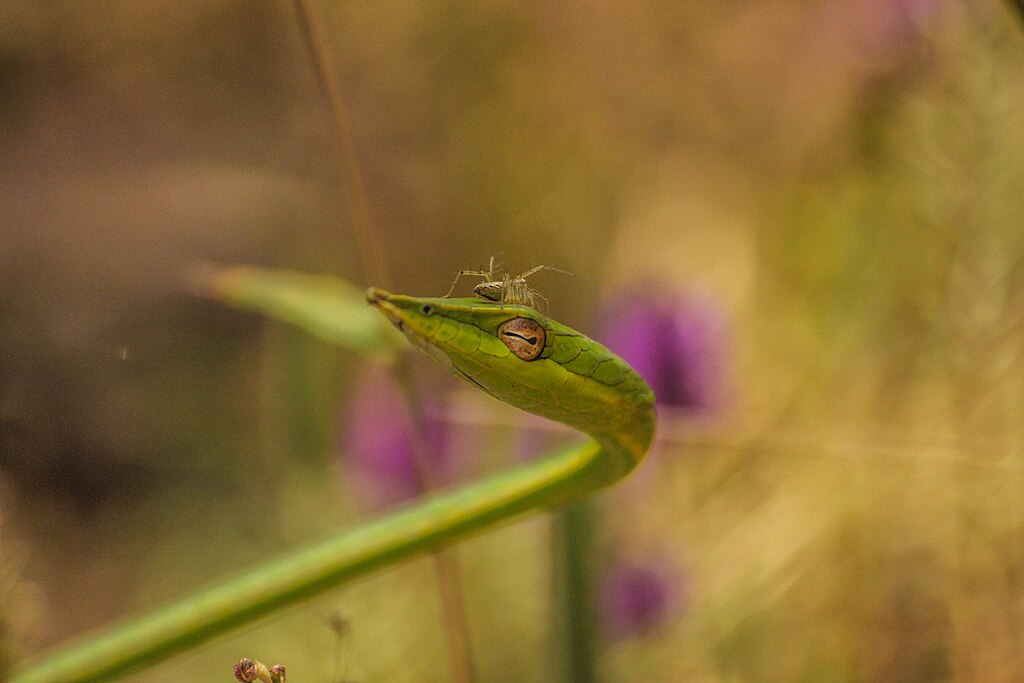
The Asian vine snake possesses a mild venom that poses little threat to humans but is remarkably effective against its small prey. Unlike front-fanged venomous snakes, this species has enlarged rear fangs (opisthoglyphous dentition) that deliver venom through a chewing motion rather than an initial strike. The venom contains compounds that rapidly immobilize small prey animals, particularly lizards and amphibians, which make up the bulk of its diet. While a bite from this snake might cause minor local swelling and discomfort in humans, serious medical complications are extremely rare. The mild nature of its venom reflects its specialized dietary preferences and hunting strategy that focuses on small prey rather than defense against larger animals.
Geographic Distribution and Habitat Preference
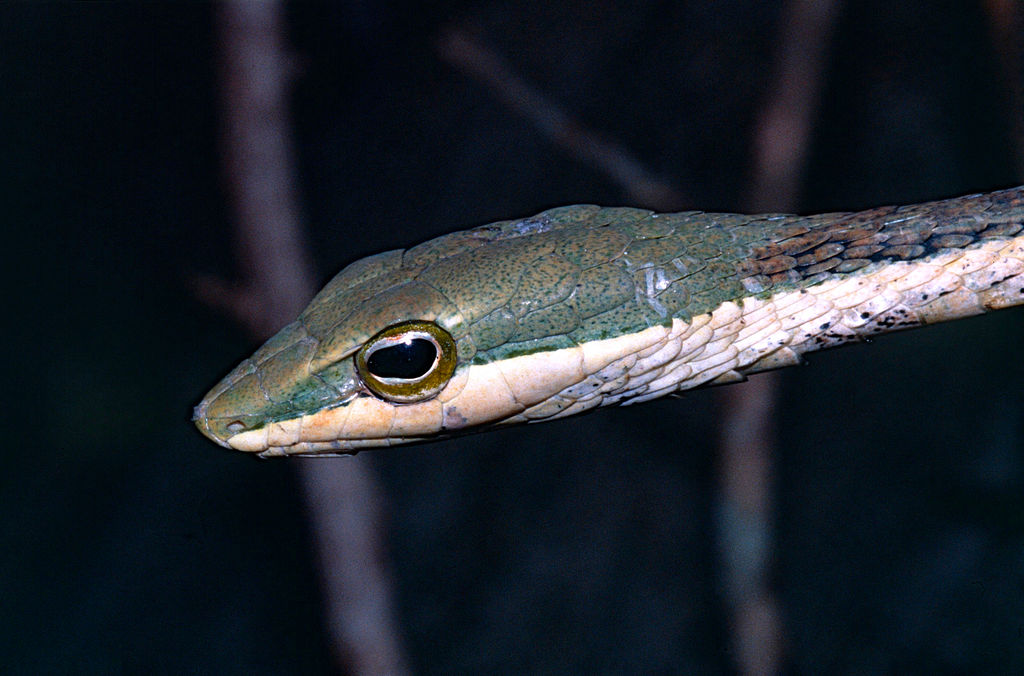
The Asian vine snake’s range extends throughout much of Southeast Asia, including India, southern China, Indonesia, Malaysia, the Philippines, and numerous other countries in the region. Within this vast distribution, the species has adapted to various forest types, showing a particular preference for tropical and subtropical rainforests with dense canopy cover. These snakes are almost exclusively arboreal, rarely descending to the forest floor except when absolutely necessary. They demonstrate a strong preference for habitats with abundant thin branches and dense foliage that maximize the effectiveness of their camouflage strategy. Within their range, different populations may exhibit slight variations in coloration that match the predominant foliage of their specific habitat.
Reproduction and Life Cycle
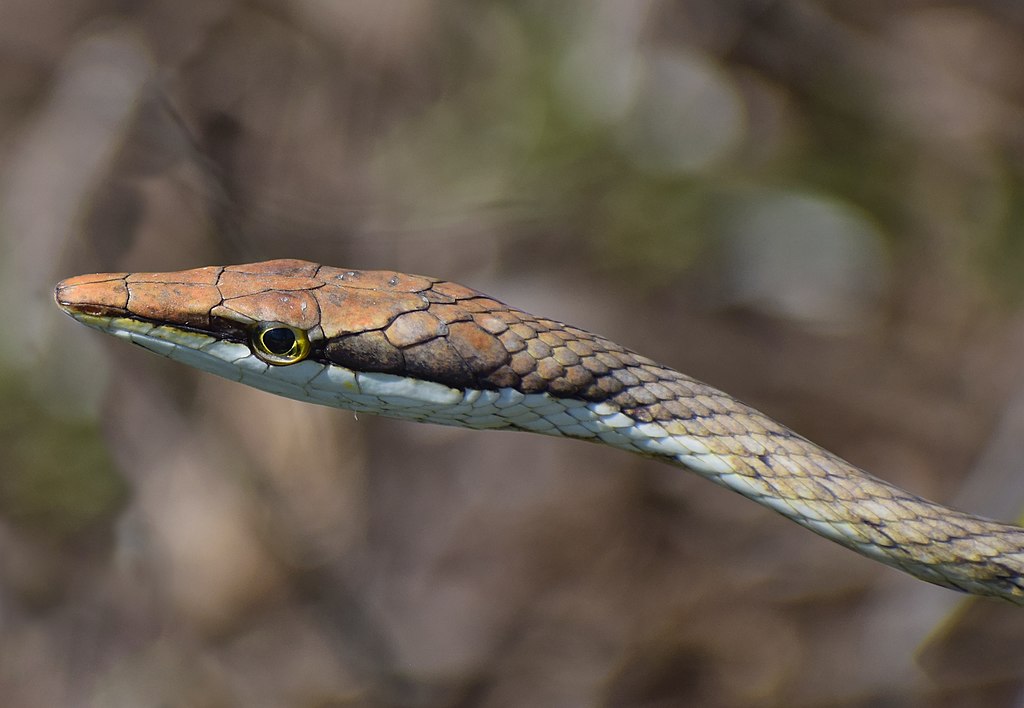
Asian vine snakes employ an ovoviviparous reproduction strategy, meaning females retain eggs within their bodies until they hatch, giving birth to live young rather than laying eggs. A typical clutch consists of 5-12 young snakes, each perfectly formed miniature versions of the adults, complete with their leaf-like appearance and instinctive mimicry behaviors. Newborn vine snakes measure approximately 8-10 inches in length and are immediately independent, dispersing into the canopy to begin hunting small insects and tiny lizards. Sexual maturity is typically reached at around 2-3 years of age, with individuals potentially living 10-15 years in the wild if they successfully navigate the many threats of forest life. The mating season generally coincides with seasonal rains when prey abundance is at its peak.
Ecological Significance and Predator-Prey Relationships

Within its forest ecosystem, the Asian vine snake serves as both predator and prey, occupying an important middle position in the food web. As effective hunters of small vertebrates, these snakes help control populations of various lizards, frogs, and small birds that might otherwise experience unchecked growth. Simultaneously, they provide food for larger predators such as birds of prey, monitor lizards, and other snakes, including king cobras. Their remarkable camouflage evolved primarily as a defense against these predators, particularly birds that have excellent color vision and hunt by sight. The snake’s ecological role highlights the intricate connections within tropical forest ecosystems and the evolutionary arms race between predators and prey that drives the development of sophisticated adaptations.
Conservation Status and Threats

While the Asian vine snake is not currently classified as endangered, populations face increasing pressure from habitat destruction across Southeast Asia. Deforestation for agriculture, logging, and urban development has fragmented much of the region’s once-continuous forest cover, isolating snake populations and reducing available habitat. Climate change presents another significant threat, as alterations in seasonal patterns and temperature regimes may disrupt the delicate timing of reproduction and prey availability. Additionally, these snakes are sometimes collected for the exotic pet trade, though their specialized dietary requirements and habitat needs make them challenging to maintain in captivity. Conservation efforts focusing on forest preservation and connectivity are crucial for ensuring this remarkable species continues to thrive.
Similar Species and Convergent Evolution
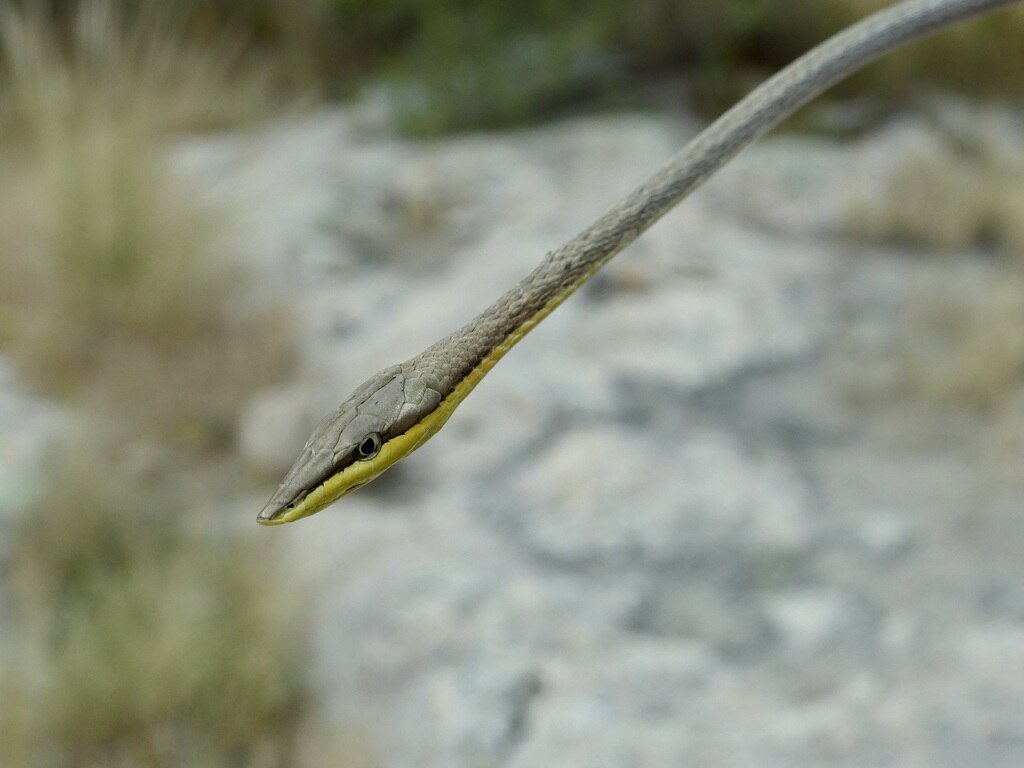
The leaf mimicry strategy has evolved independently in several snake species around the world, demonstrating convergent evolution in response to similar ecological pressures. The South American vine snake (Oxybelis spp.) exhibits remarkably similar morphology and behavior despite being only distantly related to its Asian counterpart. In Madagascar, the Langaha nasuta or leaf-nosed snake has developed an even more elaborate leaf-like appendage on its snout. Other leaf-mimicking snakes include certain species in the Dipsas genus found in Central and South America. This repeated evolution of leaf mimicry across different snake lineages and geographic regions highlights how powerful natural selection can produce similar adaptations in unrelated organisms when they face comparable environmental challenges and predation pressures.
Cultural Significance and Human Interactions
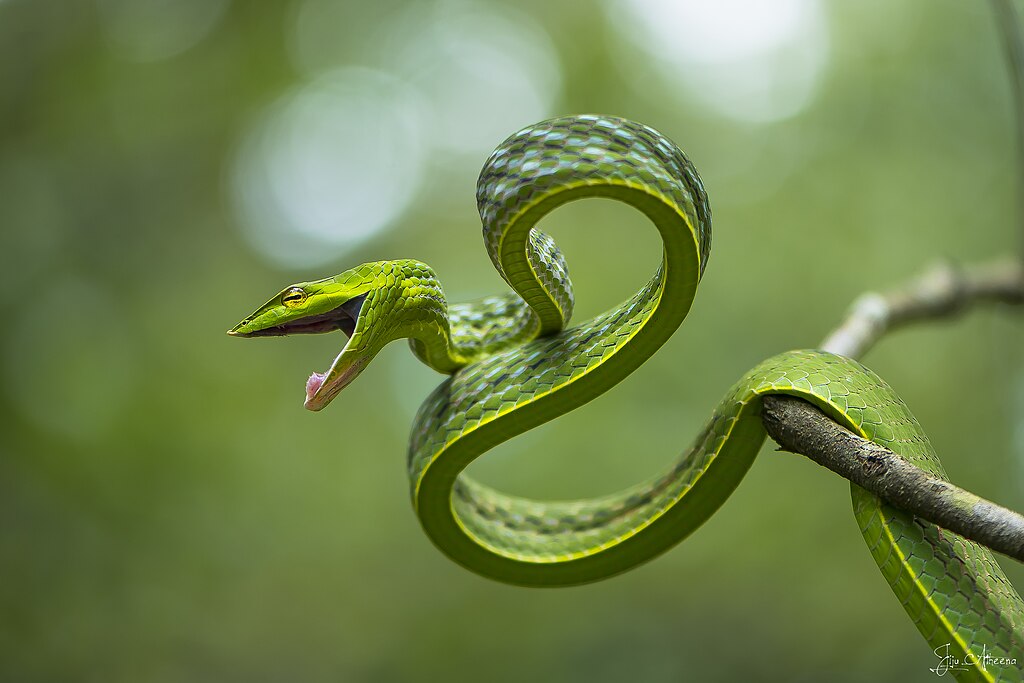
Throughout its range, the Asian vine snake has featured in local folklore and traditional knowledge systems of various cultures. In some communities, the snake is regarded with respect for its harmless nature and beneficial role in controlling pests. Traditional ecological knowledge often includes detailed observations of the snake’s behavior and habitat preferences that align with scientific findings. In modern times, the species has become popular in wildlife photography and nature documentaries, where its remarkable camouflage makes for compelling visual storytelling. Unlike many snake species that trigger fear or persecution, the vine snake’s non-threatening nature and fascinating adaptations have generally fostered more positive human attitudes, though misconceptions and needless killing still occur in some areas.
The Future of Falling Leaf Mimicry in a Changing World

As human activity continues to transform tropical landscapes across Southeast Asia, the future of specialized species like the Asian vine snake depends largely on conservation decisions made in the coming decades. The complex mimicry that evolved over millions of years may face new challenges as forests become increasingly fragmented and climate patterns shift. Some research suggests that highly specialized species with narrow ecological niches may struggle to adapt to rapid environmental changes compared to more generalist species. However, the vine snake’s wide distribution across different forest types and elevations provides some resilience against localized threats. Conservation strategies that maintain forest connectivity through wildlife corridors and protect diverse habitat types will be essential for preserving this living example of evolution’s creative power for future generations to study and appreciate.
The Asian vine snake represents one of nature’s most elegant solutions to the eternal challenges of survival – finding food while avoiding becoming food. Through millions of years of natural selection, this remarkable reptile has refined its appearance and behavior to achieve what seems almost like botanical sorcery – transforming itself into a falling leaf. As we continue to explore and understand the intricacies of such evolutionary adaptations, we gain not only scientific knowledge but also a deeper appreciation for the countless ways life has found to thrive in even the most competitive environments. The humble leaf snake reminds us that sometimes the most effective strategy isn’t to outrun or overpower one’s enemies, but simply to disappear in plain sight, swaying gently with the breeze while the world passes by, unaware of the perfect deception taking place before its very eyes.





